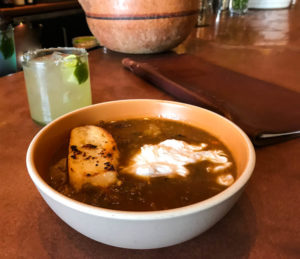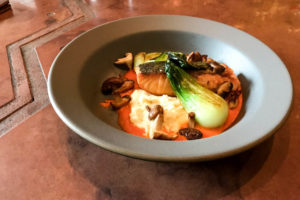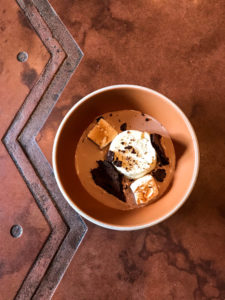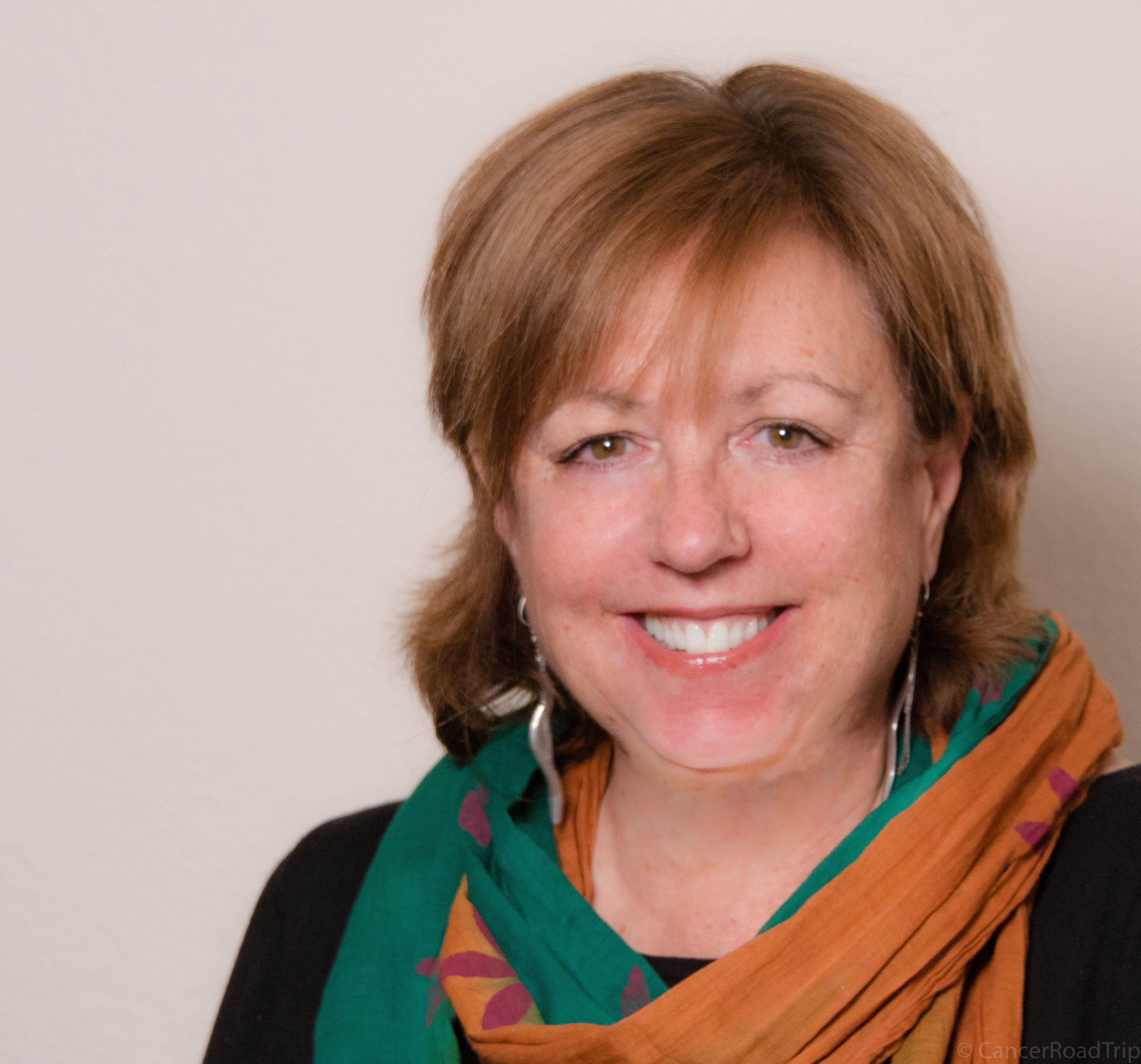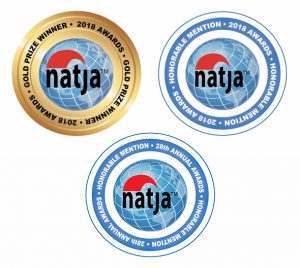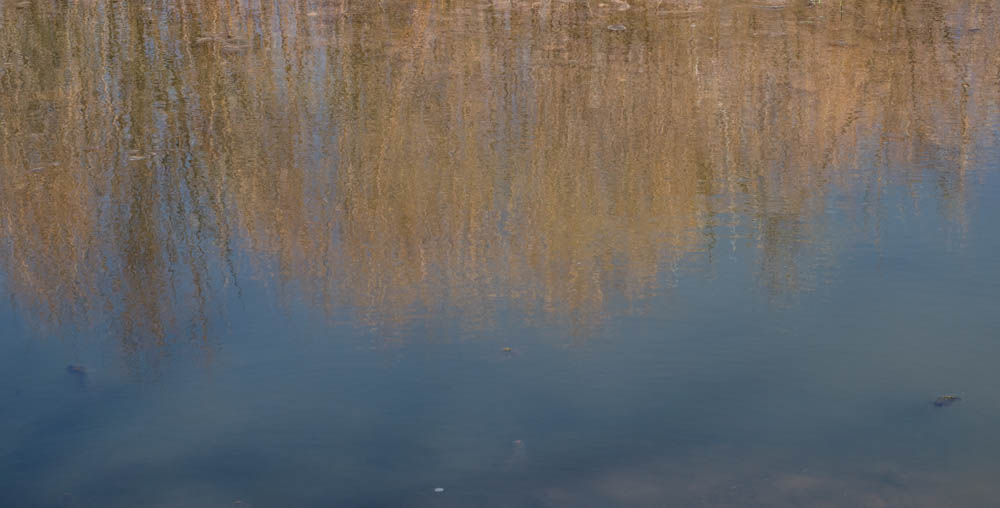
by Pat Wetzel | Mar 26, 2018 | Road Trip, The Story
Song and sound travel with me, in my memory and in the wind chimes outside the kitchen window.
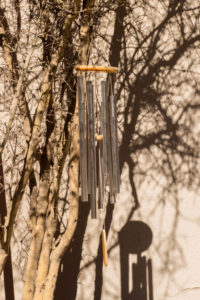
Wind chimes sway at the entry to the casita
I have settled in Santa Fe for a bit. I’ve found a wonderful casita, this one large enough to live in for a while. It is in the country, just eight minutes from the plaza, but in a different direction than the AirBnB where I first landed, and more affordable.
There is a master bedroom, bath and walk in closet; a kitchen/family room with a fireplace; and an office/bedroom with a second bath. I’ve moved some of my things from storage into this casita. It’s interesting to be reunited with some of my possessions since I am not in a possessive state of mind.
Which brings me to my wind chimes. To some degree, whatever came out of the storage pod is what I have. I have some things that I truly enjoy; others are still somewhere in a box. It doesn’t matter. I have enough.
One box I happened to open contained several sets of wind chimes. Not my favorite Maine chime whose sonorous voice is that of Mt. Desert Island harbor buoy. That chime gongs mightily in a deep wind, and although its sound pleases me, it may not please others. But my three other wind chimes appeared and I have them strategically placed.
One which lived in my former garden is now outside the kitchen window. I love its soft lilting chime and because it’s small, it readily sings.
The larger chimes that used to live on my front porch are again on my front porch, welcoming everyone who enters.
And the chimes that once hung on the trellis outside my bedroom, are again outside my bedroom window. They hold memories of lying in bed during chemo, listening to the birds, wanting to be well. Every morning and night they accompanied me and they do so again.
Timeless music to my ears; past and present; the wind moves with me. Or perhaps I move with the wind. Either way, we find ourselves together in a new place.
Santa Fe is a fascinating town. It’s healing cultures run deep; its depth of thought is far ranging; and the artistic presence is second to none. It’s beautiful, soulful and welcoming. It’s a perfect place to launch CancerRoadTrip.
And it’s restaurant per capita ratio is outstanding, a fact not lost on me. There are seemingly endless places to explore, in town and in the general area. More culinary travels to follow.
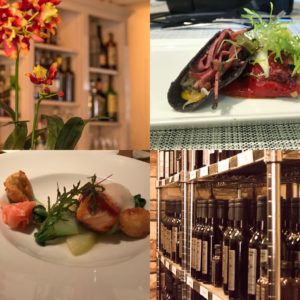
Santa Fe is a #foodie delight
(Please note that my foodie tendencies are not my doing. I really had no choice in the matter. I inherited my father’s mother’s sense of cooking and puttering the kitchen; and the travels of my younger years firmly cemented my interest in food. I once tried to count how many times I’d been to Paris and it seems to me that once the count got over 30, I gave up counting. Needless to say, I love French food.)
But back to Santa Fe, where I’d like to share some of my healing adventures. One is a recent visit to Ojo Caliente.
Ojo Caliente
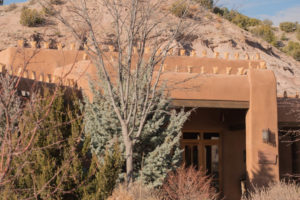
The main spa entrance at Ojo Caliente
It was a cool day; the temperature would reach the fifties, and a wind was forecast for the next day. Indeed, I watched as lenticular clouds lined up on the mountain ranges, presaging a change in weather. A front that would bring some much needed moisture was on its way.

The view from the top of the mountain near the P’osi Pueblo site
But today, it is fairly still. I arrive at Ojo Caliente with a new Santa Fe friend, and we set off to hike before submerging ourselves in the mineral waters.
The walk to the trailhead passes a wooden fence, a coyote fence, typical of this part of New Mexico. But on this fence balance sets of stones. And stacks of stones appear here and there throughout the hike to the top of the mesa. I have no idea what they symbolize, but they seem to provide a sense of companionship and community as they share our trek.
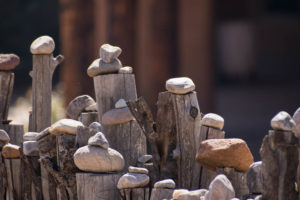
Stones balance on a coyote fence en route to the trailhead
Ojo Caliente has a rich Native American history of being a gathering place. For centuries people have come to the mineral waters to heal mind, body and spirit. It’s located at the base of a spectacular rock formation. Pools with varying blends of waters, minerals and purposes tuck into the base of the cliff.
There is something ancient and earthy about Ojo Caliente. And it is the stuff of legends, as well as the location of past civilizations.
Before entering the spa, it is time for a hike, to the P’osi Pueblo and back, and then up the river and back. Both are beautiful, but if you have to choose one, and can navigate the steep, rocky terrain, you want to visit the Pueblo site.
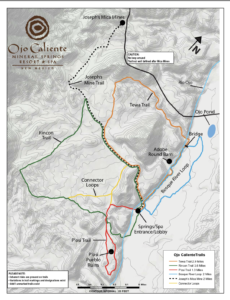
The map from the Ojo Caliente website with hiking directions for the cliffs behind the spa
The initial climb is a bit steep and requires sure footing, but it’s not that far, and after that, the path levels off. I have my Urban Poles, a gift from the company, that help me navigate the landscape.
Deep gorges carved by water wind along the path and the flat expanse of the arroyos beckons for exploration.
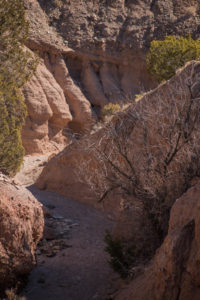
Deep gorges parallel the hike above Ojo Caliente
The mountain top plateaus and here is where the P’osi Pueblo once stood. The Pueblo was built using many of the same methods as the Taos Pueblo. You can click here to get a visual image of that community.
This was one of eight Pueblos along the Rio Grande during the fourteenth and fifteenth centuries, and it was estimated to have had 10,000 inhabitants. The Pueblo was believed to be three stories, with 2-3,000 rooms. The Tewa, descendants of prehistoric people, lived here for two hundred years before an epidemic forced them to move. They disappeared just before the Spanish arrived searching for gold.
The stories of the Tewa people say that this is the Pueblo where the Summer and Winter people came together, and farmed the lush, fertile valley of the river, growing cotton, corn, beans and squash. “Tewa” includes the people of the Taos, Santa Clara, Okhkay Owingeh (San Juan), Santa Clara, San Ildefonso, Nambe, Pojoaque and Tesuque Pueblos who all share a common language. Summer and Winter people refer to the two groups of Tewa that traveled the Rio Grande and the Rio Chama. When they reunited, they built Posiouinge.
Literally translated Poseouinge (P’osi for short) becomes “village at the place of the green bubbling hot springs” or it is also referred to as the “Greenest Pueblo”. It is a sacred place. The Pueblo was originally sited on the mesa overlooking the river, but today, nothing of the building remains, but scattered over the mesa are chards of pottery dating back hundreds of years. This sacred land is a modern day archeological treasure.
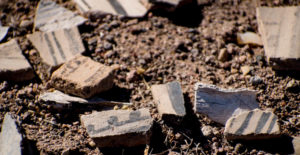
Chards of pottery litter the old Pueblo grounds.
For me, the site had a very personal feel. The various chards of pottery conjured up images of women creating and decorating the vessels for everyday use. Who were they? What actually happened to them? Where are their descendants?
After a self-guided tour of the mesa, compliments of a Bureau of Land Management pamphlet, it was time to visit the river. A path along the water yielded some beautiful views, even in winter:
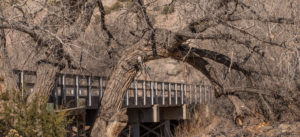
The bridge into the spa, over the river
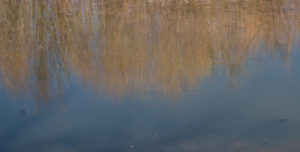
Reflections in the river.
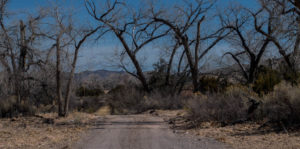
The road along the river, even in winter, is stunning.
But it is time to spa.
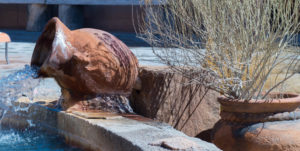
Warm mineral water from deep in the earth pours into the Arsenic Pool.
There are four pools, each with a specialized mineral content to address specific ailments:
The Arsenic Spring helps with arthritis, stomach ulcers and to heal a variety of skin conditions. It is tucked into the base of towering cliffs, whose coloring changes with the angle of the sun.
The Lithia Spring is believed to relieve depression and aid digestion.
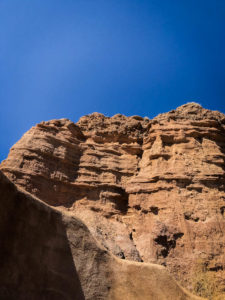
The towering cliffs adjacent to the mineral pools
The Soda Spring addresses digestion. It is housed in a small house that offers silent soaking and contemplation.
The Iron Spring is, of course, rich in iron, to bolster the blood and immune systems. The warm water bubbles up through a natural pebble floor that gives beneath your feet. A Native American legend has the large rock in the pool is guarding the spring, to be sure it remains accessible to everyone.
The Mud Pool Slather yourself with mud, bake until dry, soak and rinse! The mud is said to pull toxins from the body.
Over 100,000 gallons of water bubble up through the Ojo Caliente Mineral Springs daily, ranging in temperature from 80 up to 109 degrees. Pool hop, slather yourself in mud, or book any of the spa services. Choose from a Native Blue Corn and Prickly Pear Salt Scrub, a Milagro Relaxation Wrap, or a more typical range of spa pleasures.
Whatever one decides, it is a good choice.
Ojo Caliente is a unique blend of spa indulgence and earthiness. It retains the sense of connection to the earth, wind and time. It isn’t overly glitzy and it certainly isn’t manufactured. Yet it offers a full range of spa services, in addition to the mineral pools, and a restaurant and wine bar. There is also lodging available.
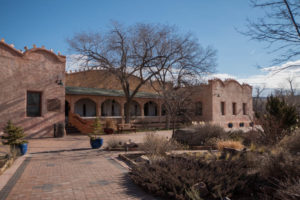
The Restaurant at Ojo Caliente
And believe it or not, I did not try the restaurant (this visit). My friend’s husband’s home smoked some extraordinary salmon, and we indulged in smoked salmon wraps pool-side.
Ojo Caliente has passes for locals that bring the cost of a visit down to under $20. If you bring your own towel and robe (and you are welcome to do so), it’s not a budget breaker. But it certainly is an indulgence.
One you should seriously consider should your healing travels bring you this way.
More Reading On Ojo Caliente and Environs:
Winter Zen in Santa Fe: Upaya and Ojo Caliente
Ojo Caliente Encore!
Photo Mission: Winter at Taos Pueblo
Photo Mission: Cold
Winter in a Santa Fe Casita
The Art, Culture and Beauty of Santa Fe
Thoughts on the Metaphor of a Road Trip
Like This Post? Pin It!
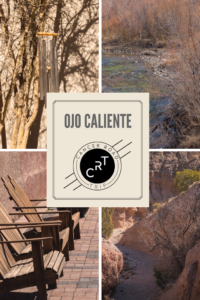
If you’re interested in learning more about photography (or cooking or film or any number of topics) check out Masterclass for on-line excellence:

[et_bloom_inline optin_id=”optin_10″]
What is #CancerRoadTrip and how did it come to be? Read this post to get the backstory!
Follow me on Twitter, Pinterest, Instagram, and at Anti-Cancer Club. Connect with me! I may need a place or two to stay along the way!
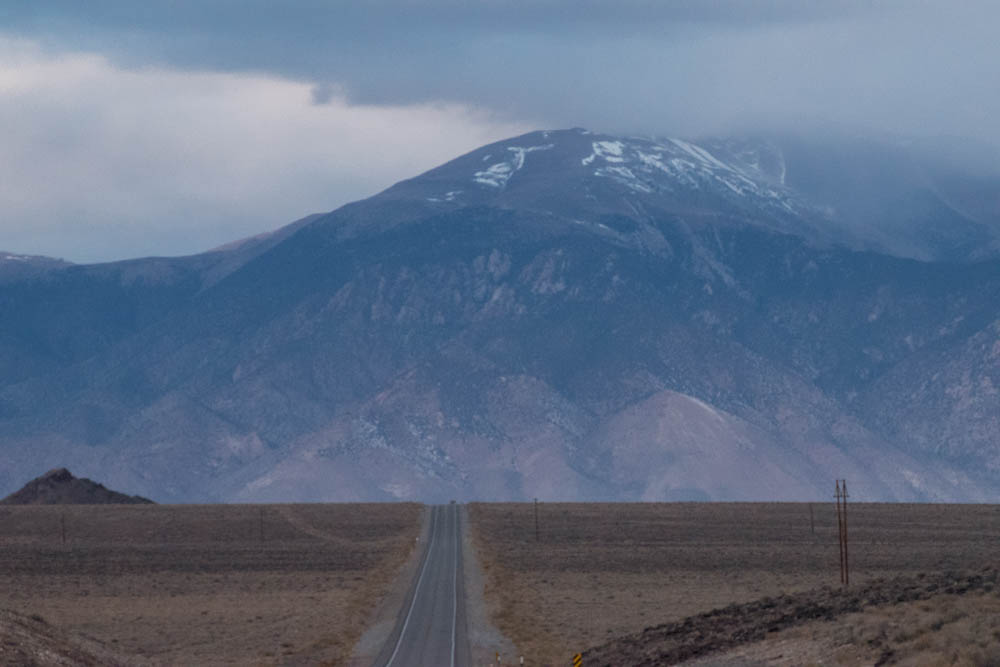
by Pat Wetzel | Mar 17, 2018 | Perspective, Road Trip, The Story
I wish I were on a road trip of unlimited possibility. The road never ends and all of that.
But I’m not.
I’m in my sixth decade and face some health challenges. So far I’ve been able to manage things fairly well, but that may or may not last.
As a result, my road trip has some limitations which makes it all the more poignant. I’m not on a search for novelty; I’m more on a quest of experience.
“Experience of meaning” is a phrase I came across recently. Joseph Campbell in an interview with Bill Moyer said:
People say that what we’re all seeking is a meaning for life. I don’t think that’s what we’re really seeking. I think what we’re seeking is an experience of being alive, so that the life experiences that we have on the purely physical plane will have resonances within that are those of our own innermost being and reality. And so that we actually feel the rapture of being alive, that’s what it’s all finally about, and that’s what these clues help us to find within ourselves.
Bill Moyers so elegantly responds…
You changed the definition of a myth from the search for meaning to the experience of meaning.
And all good road trips lead to the “experience of meaning”.
Let me share a flying story, from an earlier (aerial) road trip:
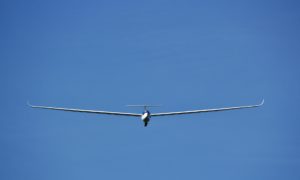
Soaring through the skies
Sun streams through the canopy. It is brilliant, warm and enveloping. The sky is blue and below the saphire-turquoise waters of Tahoe lie like a jewel on the earth.
I sit in the cockpit, a thin fiberglass shell held aloft by 15 meters of flexing wing. At the edge of each wing is a small winglet that projects vertically into the sky.
I bank the plane, the tiny winglet parallel with the earth, searching for lift.
I feel lift under the winglet. It’s a bubble of air and I balance on it. The plane and I are one. Together we rise–we dance– into the sky.
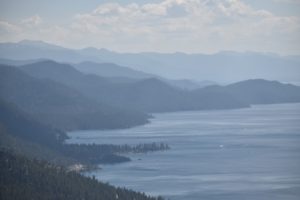
Lake Tahoe
Warm sun streams through the cockpit. Endless blue sky; Tahoe below.
It was a moment of perfect synchronicity. The energy of the air, the warmth of the sun, the beauty of the earth.
And for that timeless moment, all was one.
Sun, energy, beauty. And I was riding in the midst of it all, connected to it all, now and forever.
This moment has stayed with me and its intensity hasn’t diminished with time. It’s an experience that gave me a sense of knowing that is rooted in the unknowable. It’s a feeling of timeless, complete connection and joy.
“Eternity is that dimension of here and now which thinking in time cuts out.” –Joseph Campbell
Is this perhaps the “experience of meaning” that Joseph Campbell and Bill Moyers are exploring? An amorphous knowing not easily shared? A deep and soulful encounter with eternity?
Our souls need nourishment. They thrive on a bit of mystery and ambiguity that lead to a deep sense of knowing. The fun of travel is that it’s not just metaphorical; the answer lies just around the bend!
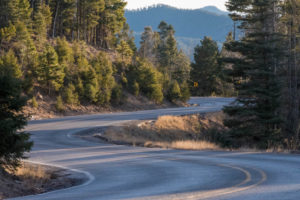
The winding road, this one from the ski hill outside of Santa Fe
The metaphor of the road trip is an old one, embedded in our discourse. Fork in the road; bump in the road; the road to ruin. Twists and turns. What is the magic of the road?
I believe it’s a sense of present moment awareness–so present on a road trip– that opens our non-thinking selves to deep and moving impressions.
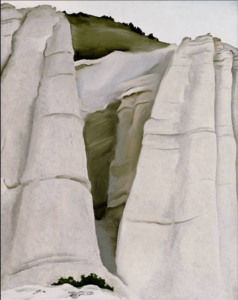
Georgia O’Keefe’s painting of Plaza Blanca
I visited Plaza Blanca recently. It’s a dramatic landscape a bit off the beaten trail. Georgia O’Keefe memorialized it in From the White Place, painted in 1940, oil on canvas. An uneven rutted road leads to the rock formation. My car was not made for off road driving, and I carefully picked a path through the desert dirt to the parking area.
I got out.
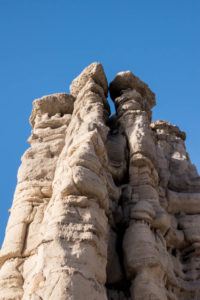
The rocks of Plaza Blanca
I was immediately engulfed in a profound sea of silence. Silence so deep and endless it was nearly palpable. An eternity of silence amidst the eroding towers of rock.
As I write this, I can still feel the silence, the slight wind as it passes by without a sound. It was an “experience of meaning”, a connection with eternity.
Cancer often leads to an “experience of meaning” in that it takes us out of our heads and into our souls. In this way it can be a gift. Gilda Radner once said: “If it wasn’t for the downside, having cancer would be the best thing and everyone would want it.”
If it wasn’t for the downside.
With cancer, the world becomes very real, very quickly for most of us. That which is not essential is eliminated. That which is meaningful remains.
And it’s here that the “experience of meaning” may have a chance to take root. People talk of the impact of the beauty of a flower; the charm of a small bird outside the window; the touch of a loved one. Here in this place beyond our minds is an experiential road trip. That’s the road trip for me. And hopefully for all our souls.
***
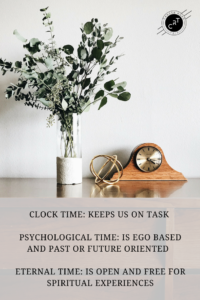
Three types of time
This past week, I wrote a piece about my cancer experience. It’s a chronology of tests and treatments. A friend of mine, knowing a bit of the background, commented: “It’s amazing what we survive.”
Cancer or not, I think we all want to do more than survive. But to fully live, we need to be open to the magic of the moment to have the “experience of meaning”.
With cancer, the recognition that time is limited becomes part of our reality. We quickly learn to focus on the here and now, and what is important. Clock time fades away; we may get stuck in psychological time; but elements of eternal time seem to crop up more often.
And with the recognition that an eventual deadline approaches, one realizes that each moment counts. This is the gift, the meaning of time and the experience of meaning that often eludes us in our frantic daily lives.
***
Question: So what is the real meaning of a road trip?
Answer: What is the meaning of life?
Let me leave you with a Zen koan:
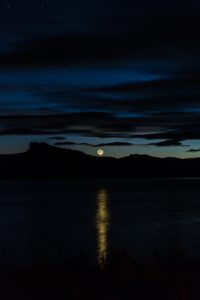
Photo by Patrick Hendry on Unsplash
Enlightenment is like the moon on the water.
the moon does not get wet, nor is the water broken.
Although its light is wide and great,
The moon is reflected even in a puddle an inch wide.
The whole moon and the entire sky
Are reflected in one dewdrop on the grass.
–Dogen
Safe travels everyone.
More Reading on the Experience of Meaning:
Serendipity: Life Lessons From The Road
Traveling The Timeline of Now
11 Life Lessons Learned From The Road
Namaste
Weathering The Storm
Change
Flying and Sex
Childhood Dreams
Like This Post? Pin It!
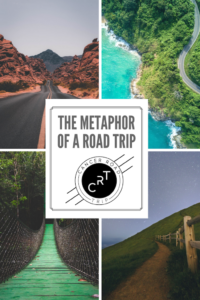
If you’re interested in learning more about photography (or cooking or film or any number of topics) check out Masterclass for on-line excellence:

[et_bloom_inline optin_id=”optin_10″]
What is #CancerRoadTrip and how did it come to be? Read this post to get the backstory!
Follow me on Twitter, Pinterest, Instagram, and at Anti-Cancer Club. Connect with me! I may need a place or two to stay along the way!
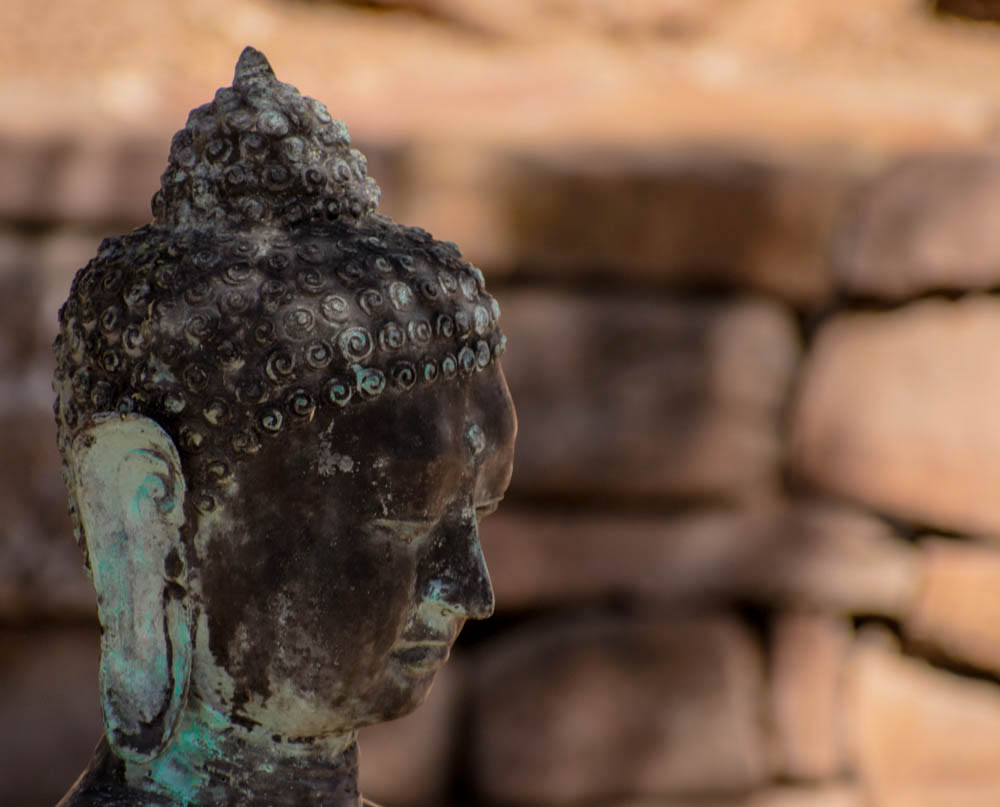
by Pat Wetzel | Mar 12, 2018 | Featured, Road Trip, Santa Fe, The Story
Have you been curious about a zen retreat, such as meditating at Upaya or perhaps visiting Tibet?
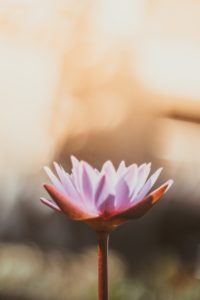
Photo credit: Ahmed Saffu, Unsplash
Images of smiling Buddhist monks, flowing robes and the sounds of beautiful bells probably come to mind. Chirping birds, beautiful pathways, flowers and fresh air.
And silence, as the monks pursue their tasks and meditate.
The Buddists use meditation as part of their quest for enlightenment. Meditation has no religious overtones. Like its counterpart mindfulness, it is simply about being still and quiet in this busy world. The benefits of stopping to be still can be considerable.
It was the healing aspects of meditation coupled with a need to manage stress and life with cancer that caused me to start exploring this path. Learning to meditate and incorporating its benefits into my daily routine has changed my life.
Someone recently asked me about meditation and why I found it so powerful. Let me try to conjure up an analogy:

The yin and yang of black and white
First, imagine you only see white.
Think of white as the constant noise of TV, conversations, life in general. In white there are market lists, to do lists, thoughts about the past and the future. Your mind jumps from topic to topic, conversation to conversation, past to future. The mental buzz is unending. It’s society’s matrix and its probably where you spend most of your time.
Now introduce black.
There is stillness.
There are no lists or noise, no distractions or requirements, no past or future.
Just stillness. You feel the peace and serenity.
Pause and consider that for a moment.
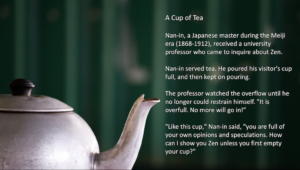
The Zen Koan, A Cup of Tea
In peace, in the absence of (psychological) time, there are no thoughts. The quiet you find is extraordinary. Revolutionary. Game changing.
Observe your thoughts. Let them fall away.
At first this stillness may be elusive, but with practice, you can learn to take it with you, wherever you go.
The trick is navigating the external matrix without losing the internal stillness.
So it is that meditation is part of my daily routine. And this Sunday I joined a half day “sit” at Upaya, called “The Ease and Joy of Mornings”.
Upaya is a well known zen monastery and retreat in the hills above Santa Fe. It is accessed via an un-prepossessing, unpaved road. Clouds of dust rise as a car passes and a dirt driveway appears dropping off steeply to the right.
Welcome to Upaya
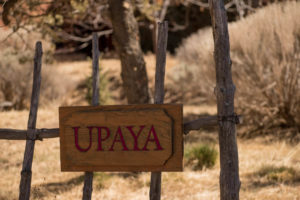
A simple sign outside the Zen monastery greets the visitor
A friend had invited me to three hours of Zazen (sitting meditation) broken with intervals of Kinhin (Walking Meditation). Meetings are held in the zen-dō, a spiritual dōjō where meditation is practiced.
This was my first Zen “sit” and I approached it with curiosity and the hope that a three hour session won’t be too much for my chemo joints or my sometimes busy mind.
The word “Zen” derives from the Sanskrit word “dhyana” which translates into “meditation” or “absorption.” In Chinese, the word is “Chan”; in Japanese, “Zen”.
Zen is a form of Buddhist meditation—there is nothing to believe in, and nothing special to do or be. One need not wear robes or shave one’s head. One is simply present.
Upaya Institute and Zen Center is one of several Buddhist monasteries in the area. It’s not a fancy place. The accommodations at the monastery are, well, monastic.
On the surface, the monastery and Zen Center radiant peace, but a brief look at the schedule shows what a culturally and intellectually dynamic place Upaya is.
On the peaceful side of the equation, daily meditations are open to the public at 7:00 am, 12:20 pm and 5:30 pm and one is warmly welcomed.
On the intellectual and cultural side of the equation, Upaya simply rocks. Weekly talks and programs on topics ranging from Buddhist teachings to art, neuroscience and other topics are offered to anyone who would like to attend. Wednesday evening Dharma talks are also open to the public.
But my interest this day is on experiencing an extended morning of meditation at this beautiful retreat.
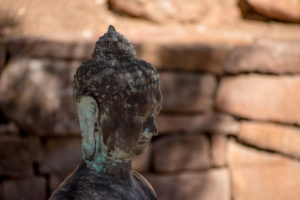
A mediating statue outside the entrance to the zendo
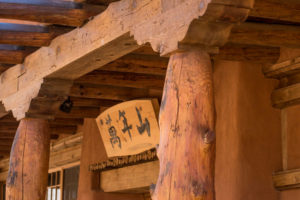
The entry to the Upaya zendo or meeting hall.
The atmosphere is kind, open and friendly. A good number of participants this morning were newbies like myself. In addition to cushions, chairs are placed along the wall, should sitting for extended periods be difficult. Many of us choose a chair, myself included.
Petra Hubbeling from Holland leads the group. She visits Upaya twice a year, for three months each visit. Her background of thirty years in business recruitment and management is in contrast to her current life in training a student in Upaya’s Chaplaincy Program. She reflects on her first visit:
“Being at Upaya that first time, I felt how every guest practitioner who comes here feels. I fell in love with this place, with the beauty of the center, with the beauty of the practice, with Upaya’s deep commitment to social engagement.”
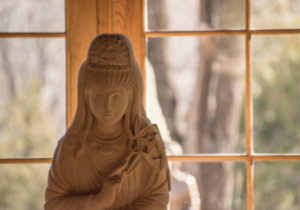
Light spills through the window into the sunroom
Petra outlines the morning agenda, explaining some of the monastery’s traditions, and we settle in to meditate in silence until the soft resonance of the gong sounds. About forty minutes, I would guess. Time does not matter. One of the apprentices is tasked with monitoring the clock. Our only task is to be present in our meditation.
“Real Zen is the practice of coming back to the actual right-now-in-this-moment self, coming back to the naturalness, the intimacy and simplicity of our true nature. Zen practice is not about getting away from our life as it is; it is about getting into our life as it is, with all of its vividness, beauty, hardship, joy and sorrow. Zen is a path of awakening: awakening to who we really are, and awakening the aspiration to serve others and take responsibility for all of life”. -Upaya website
The sound of the gong wafts gracefully through the zendo and indicates it is time to move from our still minds to our bodies, all in silence except for some instruction from Petra. We bow first to our place of meditation, then to the room. And single file, we start to walk.
“Fast, faster”, Petra beckons. “Follow the person before you. Move as they move.”
The pace quickens and the human line weaves through the zendo, into the sunroom and back.
“Now walk slowly.” The cadence changes. “Align your movement with the person in front of you. Follow your breath.”
Now the entire human line slows, in step with each breath. Each movement is exaggerated with great awareness. From heal to toe and back again. Slowly. The goal is to have the entire line move as one, with a collective awareness of each move.
We weave in a line from the zendo to the sunroom and back. The room moves as one and we return for another period of Zazen followed by another period of Kinhin . Then we break for some tea and snacks in the kitchen.
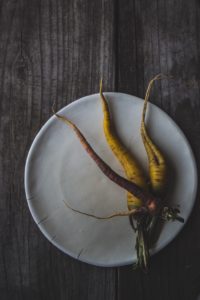
Photo Credit: by Nathan Burrows on Unsplash
The kitchen is busy and welcoming, as students mindfully chop vegetables, cook meals, wash dishes and sweep the floor. Off the kitchen, there is a smaller indoor dining area a step down, for daily dining. There is also a long patio overlooking the grounds for larger groups. We gather here until returning to the zen-dō for a discussion about the traditions of this morning sit.
Upaya was founded in 1994 by Roshi Joan Halifax, PhD. This remarkable woman is a Buddhist teacher, Zen priest, anthropologist, and a pioneer in the field of end-of-life care. She has been an Honorary Research Fellow at Harvard and a Distinguished Visiting Scholar at the Library of Congress.
Professionally and spiritually, she has focused on the psycho-social, ethical and spiritual aspects of care of the dying, particularly with cancer patients. Her influence on the field of spirituality, medicine and compassion cannot be overstated.
I have to say I am humbled, amazed and grateful to have access to such an amazing educational and cultural institution in my back yard.
The upcoming Upaya schedule for this Spring includes programs such as Rediscovering Zen’s Roots in Ancient China by philosopher and Columbia University teacher David Hinton; and a two week Japan Arts Pilgrimage, Ancient and Contemporary Art and Sacred Sites, with Roshi Joan Halifax. A full schedule of events is here.
Upaya is just one of several Zen monasteries in Santa Fe. While I’m taken with this incredible zen center, I also look forward to exploring the others. I think my interest lies in the wonderful ambiguity associated with the Buddhist train of thought, along with my already established meditation practice. I don’t see myself running off to a monastery (too many restaurants to discover!), but I am drawn to the recognition of impermanence that we all seem to seek to avoid.
In the words of the 8th-century Buddhist master Shantideva (The Way of the Bodhisattva):
All that I possess and use
Is like the fleeting vision of a dream.
It fades into the realms of memory;
And fading, will be seen no more.
–Tricycle: The Fundamental Ambiguity of Being Human
If you’re interested in some reading on meditation and mindfulness:


 This is the first book I recommend to everyone curious about meditation. The author asks you to set aside just 8 minutes a day. Week by week, he introduces new approaches to meditating. It gives you the chance to sample some different bodies of thought and decide which–if any– might suit you. An excellent place to start, and one of my first books as well!
This is the first book I recommend to everyone curious about meditation. The author asks you to set aside just 8 minutes a day. Week by week, he introduces new approaches to meditating. It gives you the chance to sample some different bodies of thought and decide which–if any– might suit you. An excellent place to start, and one of my first books as well!


The Power of Now is one of the most amazing books ever. Eckhart Tolle’s personal story takes him from homelessness to spiritual teacher.
From Amazon:
“To make the journey into the Now we will need to leave our analytical mind and its false created self, the ego, behind. From the very first page of Eckhart Tolle’s extraordinary book, we move rapidly into a significantly higher altitude where we breathe a lighter air. We become connected to the indestructible essence of our Being, “The eternal, ever present One Life beyond the myriad forms of life that are subject to birth and death.” Although the journey is challenging, Eckhart Tolle uses simple language and an easy question and answer format to guide us.
A word of mouth phenomenon since its first publication, The Power of Now is one of those rare books with the power to create an experience in readers, one that can radically change their lives for the better.”
If you haven’t read this, download it NOW! It’s one of those books you’ll come back to again and again.


This book is a classic for a reason. It’s about integrating mindfulness meditation into everyday life. It’s been updated with a new afterward by the author.
More Posts about Zen and Travel:
Winter Zen in Santa Fe: Upaya and Ojo Caliente
Thoughts on the Metaphor of a Road trip
11 Life Lessons Learned From the Road
Traveling the Timeline of Now
Travel Packing List: Quotes, Wisdom and a Minimum of Luggage
Travel Minimalist: 17 Reasons Why Less is More
Reflections on Life With Cancer
Aparigraha
Like This Post? Pin It!
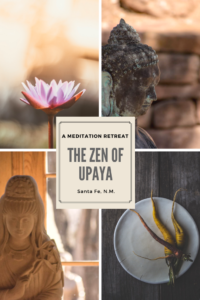
If you’re interested in learning more about photography (or cooking or film or any number of topics) check out Masterclass for on-line excellence:

[et_bloom_inline optin_id=”optin_10″]
What is #CancerRoadTrip and how did it come to be? Read this post to get the backstory!
Follow me on Twitter, Pinterest, Instagram, and at Anti-Cancer Club. Connect with me! I may need a place or two to stay along the way!
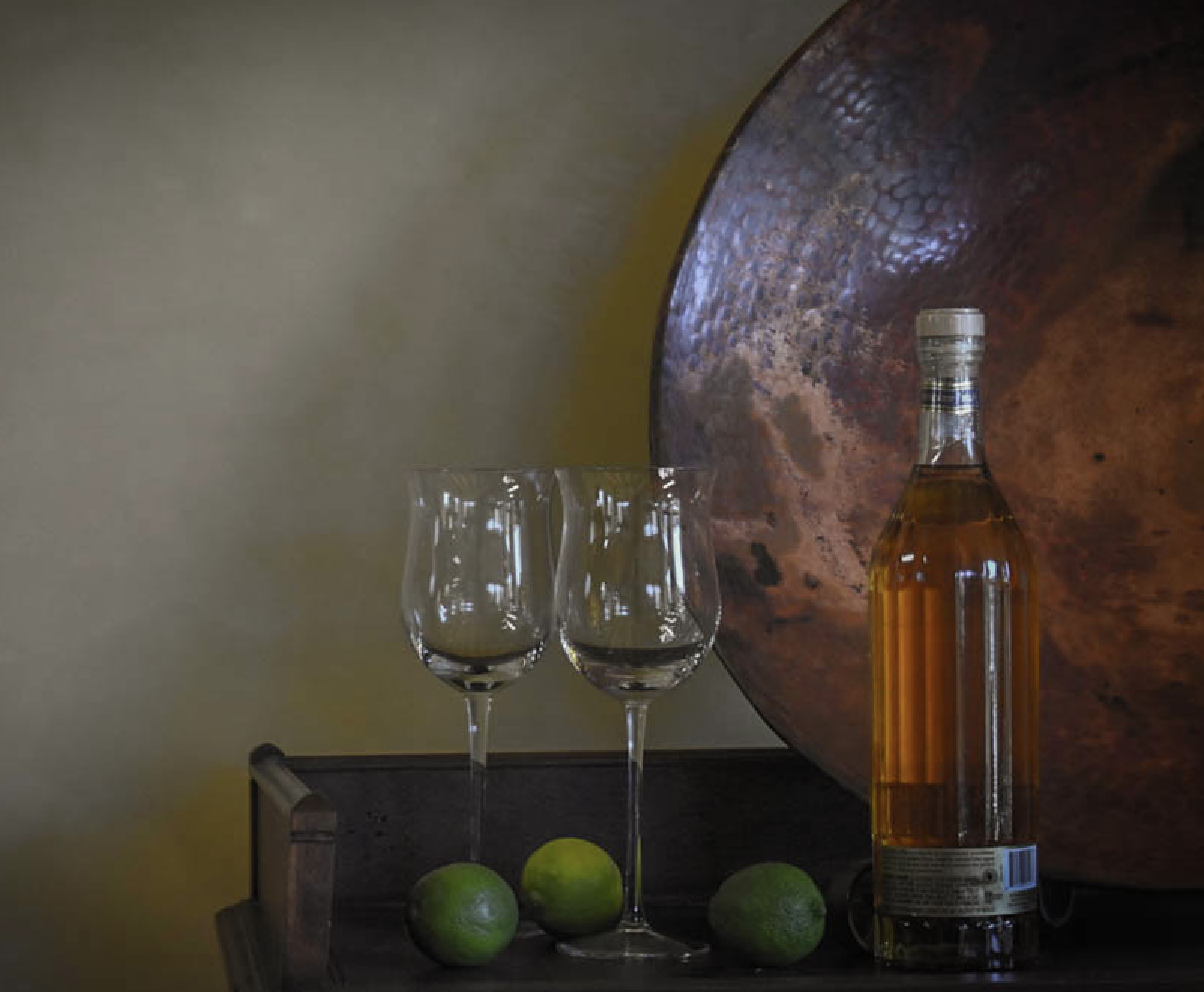
by Pat Wetzel | Mar 5, 2018 | Foodie Forays, The Story
Have you ever had great tequila?
I mean the type of tequila that is mellow like a cognac, golden to brown, and perfectly aged?
The type that swirls in your glass, coating the sides, leaving rivulets streaming down the glass.
Fragrances that transport you.
No lime, no salt.
Just great tequila.
Breath in the aroma. Notice the color. The spices, the way it slides off your tongue.
Tequila can be amazing.
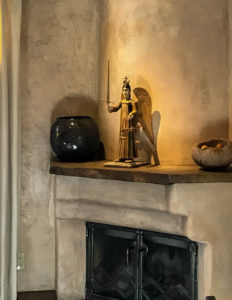
Native art work at the Inn of the Anasazi
New Mexico is somewhat synonymous with tequila, and a tequila tasting at the Inn of the Anasazi for New Mexican Restaurant Week in Santa Fe sounded irresistible on several levels.
First, the Inn of the Anasazi is a boutique hotel in the Rosewood hotel family. The entire property is elegant and understated, while showcasing New Mexican architecture, art and charm. One leaves the cold swirling air, enters the small lobby and is greeted by the warmth of a real wood fire roaring in the entry fireplace.
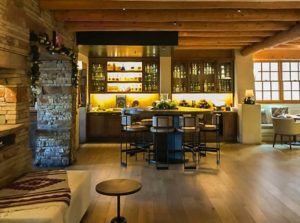
The entry to the dining room and bar at the Inn of the Anasazi
Off to the left, double doors lead to the restaurant and bar, another welcoming place, to dine, linger and savor the essence of Santa Fe.
A tequila tasting was also semi-irresistable because I was curious. I had my first real margarita over 20 years ago on a balcony overlooking the Santa Fe Plaza. And over the years, while tequila was never a main stay, it was something I was curious about. Curious to taste it, understand it and to explore it.
Thomas Avila, the Food and Beverage Manager at the Inn of the Anasazi, was the tour guide and tequila sommelier for the evening. We started with a bit of history.
Just as Champagne in France is only produced in the Champagne region, tequila is denoted by its place of origin. The map below detailing the municipalities in each region is compliments of Tony Burton/GeoMexico. In it, you can see four of the five regions where all global tequila is produced:
- Nayarit
- Guanajuato
- Michoacán
- Jalisco
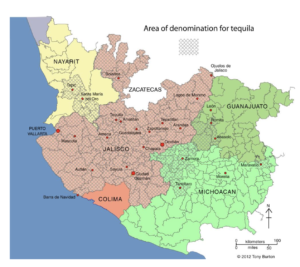
Four of the five tequila producing areas in Mexico. Credit: Tony Burton / Geo-Mexico
The fifth area, Tamaulipas is located further north, on the Gulf of Mexico bordering the United States.
Just as in wine, weather and terroir is part of what makes each tequila unique.
According to Thomas, some of the best quality tequilas come from Guanajuato and Jalisco.
There are over 200 types of agave, but tequila is made only from a specific type of agave plant “Weber Azul”. The plant is a succulent, not a cactus (contrary to popular belief), and takes eight or more years to mature to harvest. The heart of the plant, when ripe, weighs 80-200 pounds. It’s this core that is roasted, crushed and fermented.
Some tequilas are distilled up to three times, leaving only a refined, pure liquid for aging. Making good tequila is an art form, just like producing fine wine, cognac or whiskey. To make a great tequila, it’s key that there be no additives and that it contain only 100% agave.
Buy only tequila that is 100% agave.
The idea of combining lime and salt with a tequila chaser comes from World War II when tequila (which was not 100% pure agave) was combined with chemical additives, sugar and other nonessentials. This is referred to as tequila mix. The lime and salt were used to disguise the chemical flavor, not to enhance the actual beverage.
But in today’s world, tequila has gone artisanal. How do you know what you’re buying is authentic?
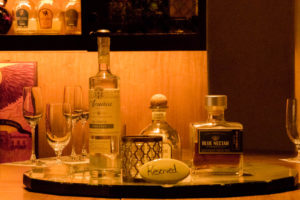
A private table for a most unique tequila tasting!
Each bottle has a NOM “Normas Official Mexicana” which is a distillery number. Various brands may be manufactured at any given distillery, so the NOM is not unique to the bottle.
Next, check for the Consejo Regulador del Tequila (CRT) logo showing that the NOM and the distillery meet the qualifications to produce tequila. This is not a stamp of quality, but of regulatory compliance.
Keep reading the label and look for the words “Hecho en Mexico” and “100% agave.” This is a moment of discernment when it comes to reading tequila labels. You want a label that reads “100% agave”, not “Made with Agave.” The latter is a mixto, not true tequila.
Now that you know you have authentic tequila, what type do you choose? Basically, there are four types of tequila:
Blanco or silver is the clear tequila that results from simple distillation. It can be aged up to two months. Look for perfect clarity and good legs as you study the liquid in the glass.
Reposado is aged two months to a year and acquires a golden color, derived from new or used oak, or any other type of wooden container. The Reposado I tasted was aged for 6 months in French oak barrels. It was, as you would expect, smoother, and more complex than the blanco with notes of spices and herbs, and a beautiful nose.
Just as in whiskies, the type of cask used for aging impacts the end product. New oak, used oak, bourbon, even used wine casks are used by artisan producers. Tequila can actually be pink as a result of aging in French White Oak barrels that have been used to produce cabernet.
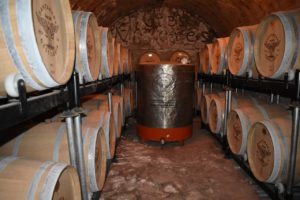
Barrels of aging tequila
The color of tequila is determined by the type of barrel it is aged in.
Añejo is aged from one and three years and acquires a darker color. The tequila in this tasting was from a relatively new company, established just a decade and a half earlier. Given that it takes eight plus years to raise an agave plant, 15 years is a relatively young company. This particular tequila was aged one and a half years in used American oak barrels. The tequila had whiskey notes, with hints of toffee, caramel and bananas.
Extra-añejo is aged more than three years and is even more cognac-like. Its rich, mellow flavor is one to be savored.
Producing Tequila
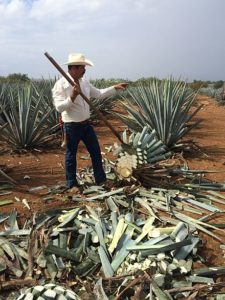
Harvesting “Weber Azul” Photo Credit: Wikipedia
The process of making tequila starts with the determination of the ripeness of the heart of the blue agave plant. Just as in grapes for wine, the decision to harvest is a critical one.
When the heart of the plant is ripe, the spikes are stripped, and the 80-200 pound heart is roasted in special ovens, long and slow, in low temperatures, gradually concentrating and gently carmelizing the natural sugars.
Then the hearts (also referred to as “pineapples”) are roasted, they are crushed, often using an old fashioned stone wheel, sometimes driven by donkey power.
And then the fermentation and aging process commences. Unlike whiskey which may be fermented in steel, the material of choice for tequila is a steel-copper combination.
Much like my Irish Whiskey experience in Killarney, I found that the variation among artisanal tequilas is almost unlimited. So much tequila, so little time! Seems like a universal problem, whether it be wine, Irish Whiskey, or whatever your beverage of choice may be.
Tequila Tasting

Just as in wine, Reidel makes glasses for tequila tasting. They are tall and narrow, allowing the fragrance of the tequila to concentrate.
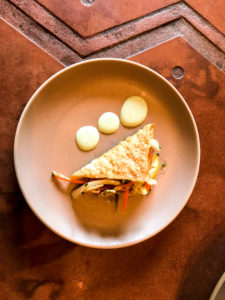
This stunning ahi taco was served with the tequila tasting
The tequilas this evening were served with a sangrita (“little blood”), a combination of fresh tomato and orange juices, lime, salt, and a bit of spice which dates back to the 1920s. It’s intended to be paired with a tequila blanco to highly the crisp acidity and to clean the palate between sips. The sangrita helps to balance the flavors, although I preferred to simply sip the tequila.
Along with the tequila, the tasting provided a bit of food in the form of a carefully crafted Ahi Tuna Taco. The taco was a combination of light, rich and flaky-crisp taco, filled with a slice of ahi, served with wasabi cream, napa cabbage, miso, and sesame.
***
For Restaurant Week, the Inn of the Anasazi also has both a dinner and lunch menu. I stopped in for the lunch menu where I ate at the bar which is made of a stunning piece of chiseled limestone. Since it just happened to be #NationalMargaritaDay, Ani, the charming bartender noted that margaritas were half priced:
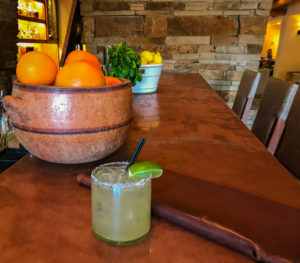
Top of the line margarita to celebrate #NationalMargaritaDay
Santa Fe Restaurant Week
Inn of the Anasazi
Lunch Menu
($35.00 per person)
Read more on my travels in and around Santa Fe:
Ana Pacheco and Jambo Cafe Kick Off Restaurant Week in Santa Fe
Warming Up to Restaurant Week In Santa Fe
Art, Flavor and Elegance at Restaurant Martin
Winter in a Santa Fe Casita
Santa Fe via Las Vegas, N.M.
Photo Mission: Cold
Photo Mission: Winter at Taos Pueblo
The Art, Culture and Beauty of Santa Fe, N.M.
Like This Post? Pin It!
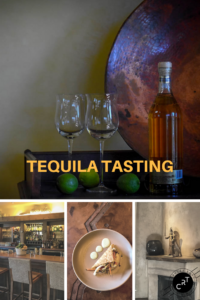
If you’re interested in learning more about photography (or cooking or film or any number of topics) check out Masterclass for on-line excellence:

[et_bloom_inline optin_id=”optin_10″]
What is #CancerRoadTrip and how did it come to be? Read this post to get the backstory!
Follow me on Twitter, Pinterest, Instagram, and at Anti-Cancer Club. Connect with me! I may need a place or two to stay along the way!


















































